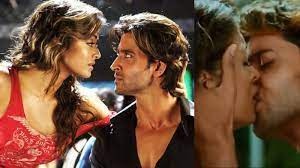The Dhoom 2 Debate in Detailed Cinematic Form
The Indian film business, or Bollywood, has a long history of being a center for variety, controversy, and inventiveness. Among the many movies that have garnered notice, Dhoom 2, which debuted in 2006, stands out for a number of different reasons. Despite being a big commercial success, the movie’s primary stars, Hrithik Roshan and Aishwarya Rai Bachchan’s kissing scene, raised ethical and legal questions. This article examines the controversy surrounding this particular scenario and considers its sociological and legal background.
The sequel to the popular Dhoom film series, which was produced and directed by Aditya Chopra. The ensemble cast of the film included Aishwarya Rai Bachchan as the gorgeous Sunehri, Hrithik Roshan as the charming thief Aryan Singh, and Abhishek Bachchan as the harsh police officer Jai Dixit.
The moment when the problematic scene emerges is a major component of the film. Aryan (Hrithik) and Sunehri (Aishwarya) are united during a passionate hug that finishes in a kiss. On its own, this would seem like a common movie incident, but in the context of India, it generated a lot of discussion and attention.
The debate about the kissing scene in Dhoom 2 led to the filing of a lawsuit. Manishankar Srivastava, an attorney, filed a Public Interest Litigation (PIL) with the Lucknow division of the Allahabad High Court. He said that both the scene and Indian cultural standards had been broken.
The Cinematograph Act of 1952 and the Indian Penal Code (IPC), which deal with obscenity and film certification, were also cited in the PIL. The kiss, in Srivastava’s opinion, ought to have been removed from the film since it was offensive to Indian audiences.
The legal dispute triggered a wider conversation about censorship, creative freedom, and the portrayal of intimate moments in Indian film.
One of the primary concerns in the legal dispute was the tension between censorship and creative freedom. Filmmakers argue that they should be allowed the creative freedom to realize their vision, in contrast to those who advocate censorship who claim that it is vital to protect cultural and moral norms.
Sanjay Gadhvi, the director of Dhoom 2, justified the decision to include the kissing sequence by arguing that it was essential to the development of the characters and the plot. He advocated against placing restrictions on storytellers and in favor of respecting their creative choices.
On the other hand, the petitioner and other conservative organizations contended that, especially in a nation with such a varied and rich culture as India, filmmakers should adhere by certain moral and cultural norms. They believed that instances like the one in Dhoom 2 set a bad precedent and may cause people to appreciate cultural values less.
India’s certification and censoring of motion movies depend on the Cinematograph Act of 1952. The Central Board of Film Certification (CBFC) must certify a film before it may be shown in public. The CBFC categorizes movies into several groups based on their content, including U (Universal), UA (Parental Guidance), and A (Adult).
Dhoom 2 received a UA certificate, signifying that film was suitable for audiences above the age of 12. The CBFC, a division of the Ministry of Information and Broadcasting, gave the movie’s contentious sequence the go-ahead to be shown.
Whether the CBFC had sufficiently taken into account the movie’s substance and followed the guidelines set out in the Cinematograph Act was what eventually determined the court’s verdict.
The Allahabad High Court rejected the PIL after considering the reasons made by both parties. The Central Board of Film Certification, a statutory authority in charge of film certification, was found to have previously reviewed and approved Dhoom 2 by the court. The court thus decided that it could not influence the CBFC’s decision.
The court’s decision brought attention to the value of the certification process and the role of statutory organizations in deciding whether a movie is suitable for public viewing. Also emphasized was the notion of creative freedom within the bounds of existing legal structures.
The controversy over the kissing scene in Dhoom 2 also highlights India’s evolving cultural perceptions. India is a multicultural country with a broad variety of cultural and social norms, therefore regional differences in what is seen acceptable or unacceptable might be substantial.
While certain segments of society were very outraged by the sequence and felt it violated traditional Indian values, others praised it as an illustration of altering societal norms and attitudes toward intimacy in movies.
Additionally, the Indian cinema industry has steadily gravitated towards more explicit material as consumers’ preferences have evolved over time. Many people thought that movies like Dhoom 2, which boldly told a tale and realistically portrayed relationships, were a reflection of the shifting cultural landscape.
The argument over the kissing scene in Dhoom 2 is a case study of the complex interactions between creative freedom, censorship, and cultural values in Indian film. The certification process and creative freedom were eventually maintained by the court, setting a precedent for future disputes even if it ended in a legal fight.
The conflict between traditional values and the changing preferences of a varied and dynamic population was also highlighted, along with how India’s cultural norms and attitudes are continually developing. In addition to the debate it inspired about the complexity of Indian cinema and culture, the film Dhoom 2 will be remembered for its thrilling action sequences.






